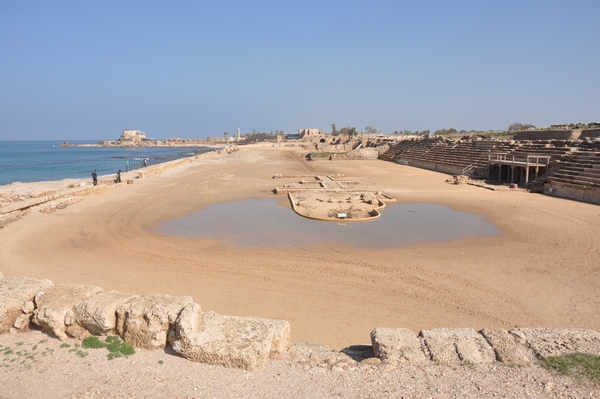What is…
Caesarea
also known as: Caesarea Maritima, Caesarea Palestinae, Palestinae, Caesarea Sebaste, Parálios Kaisáreia, and Kaiseriyeh
This is an ancient idolatrous pagan city on Israel’s Mediterranean seashore. It is located on the great road from the city of Tyre to Egypt, about 70 miles northwest of Jerusalem, at the northern extremity of the plain of Sharon. Originally a fishing village, it became Rome’s capital in Israel with a deep shipping harbor.

Caesarea was built by Herod the Great, not long before Christ. He named it after Caesar Augustus, hence called Caesarea Sebaste (Greek: Sebastos = “Augustus”), on the site of the old town called “Strato’s Tower.”
King “David built fame out of simplicity; Herod’s palace fortresses were elaborate. But, as with David, who lived for God, what matters most is not what we build, but for whom we build.” —“Total Commitment” section of video “On the Death & Resurrection of the Messiah”
Caesarea was the capital of the Roman province of Judea, the seat of the governors or procurators, and the headquarters of the Roman troops. It was the great Gentile city of Judea, with a spacious and deep artificial harbor.
It was adorned with many buildings of great splendor, modeled after the Roman cities of the West.
Cornelius
Cornelius the centurion was converted through the Apostle Peter (Acts 10:1, 24), and thus for the first time the door of faith was opened to the Gentiles.
Q & A
- Who is Cornelius?
- What is a Centurion in the Bible?
- Who is Simon the tanner?
- Who is Peter? and what is his importance?
- What is an Apostle in the Bible?
- What is a Gentile? What does the Bible say about Gentiles?
Philip
Philip the evangelist resided here with his four daughters (Acts 21:8).
Q & A
Paul’s departure and return point, and imprisonment
From this place Saul/Paul sailed for his native Tarsus when forced to flee from Jerusalem (Acts 9:30), and here he landed when returning from his second missionary journey (Acts 18:22).
Paul remained as a prisoner in Caesarea for two years before his voyage to Rome (Acts 24:27; 25:1, 4, 6, 13).
Here on a “set day,” when games were celebrated in the theatre in honor of the emperor Claudius, Herod Agrippa I appeared among the people in great pomp, and in the midst of the idolatrous homage paid to him was suddenly smitten by an angel, and carried out a dying man. He was “eaten of worms” (12:19-23), thus perishing by the same loathsome disease as his grandfather, Herod the Great.
Q & A
- Who is Paul? and what is his significance?
- Prisons in the Bible
- Who is Agrippa I, and what happened to him?
- What is the book Acts of the Apostles?
Archaeology
The city later returned to its ancient name Kaiseriyeh, and there was a time when this once great Gentile city of Judea became desolate—once described as the most desolate city of all Israel.
After the creation of the modern State of Israel, archaeologists began uncovering numerous ancient structures here dating to biblical time periods and later. Since 2000, the location has been on UNESCO’s “Tentative List of World Heritage Places.”
The modern city contains the Caesarea Antiquity Museum, a Roman theater, hippodrome, and other ancient sights.
More information
- About idolatry and false gods in the Bible
- Who is Herod the Great? and what did he do?
- About Ancient Rome in the Bible
- About caesars in the Bible
- What is Caesara Philippi?
- Kings of the Bible
- The Sea (Mediterranean)
 Bible archaeology discoveries
Bible archaeology discoveries
